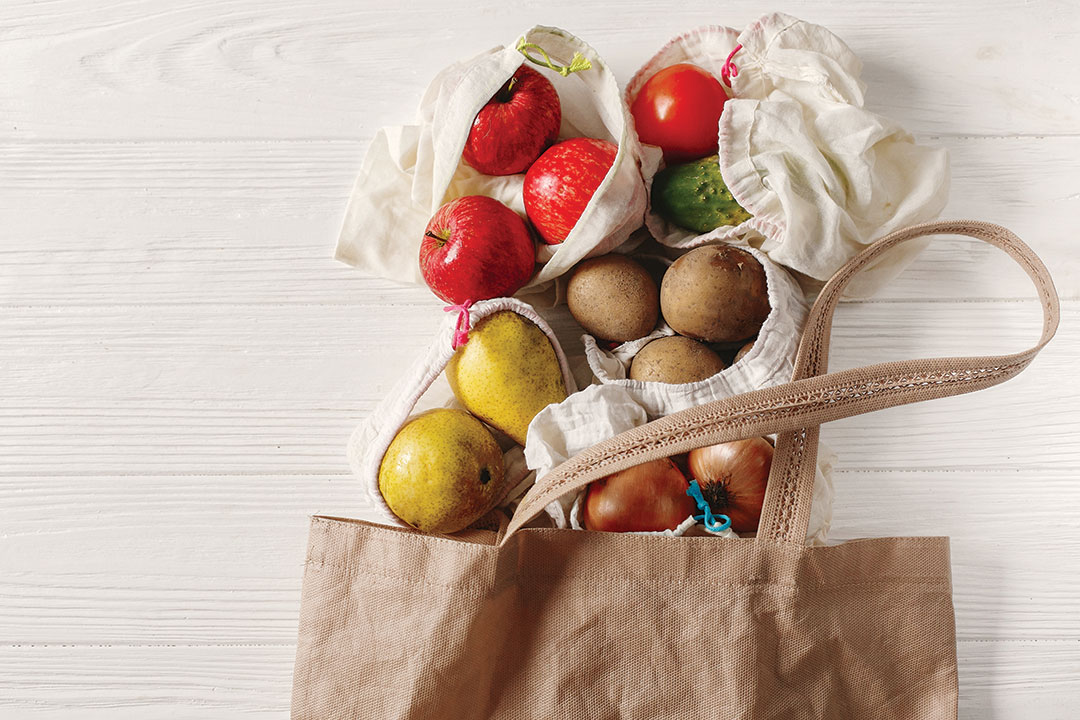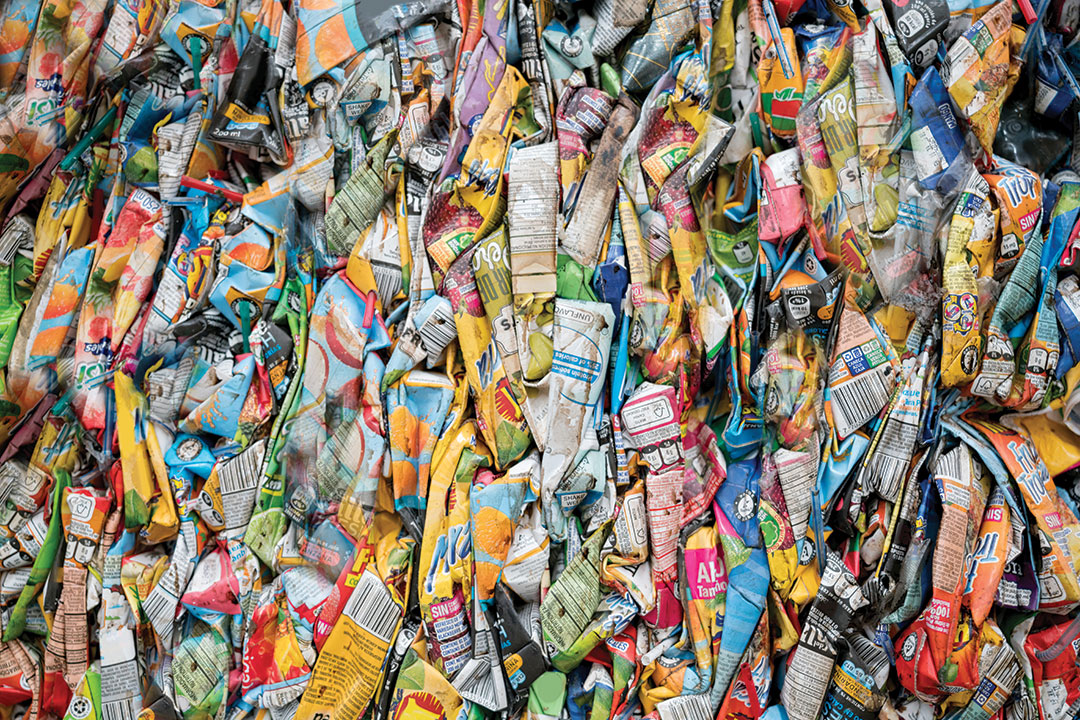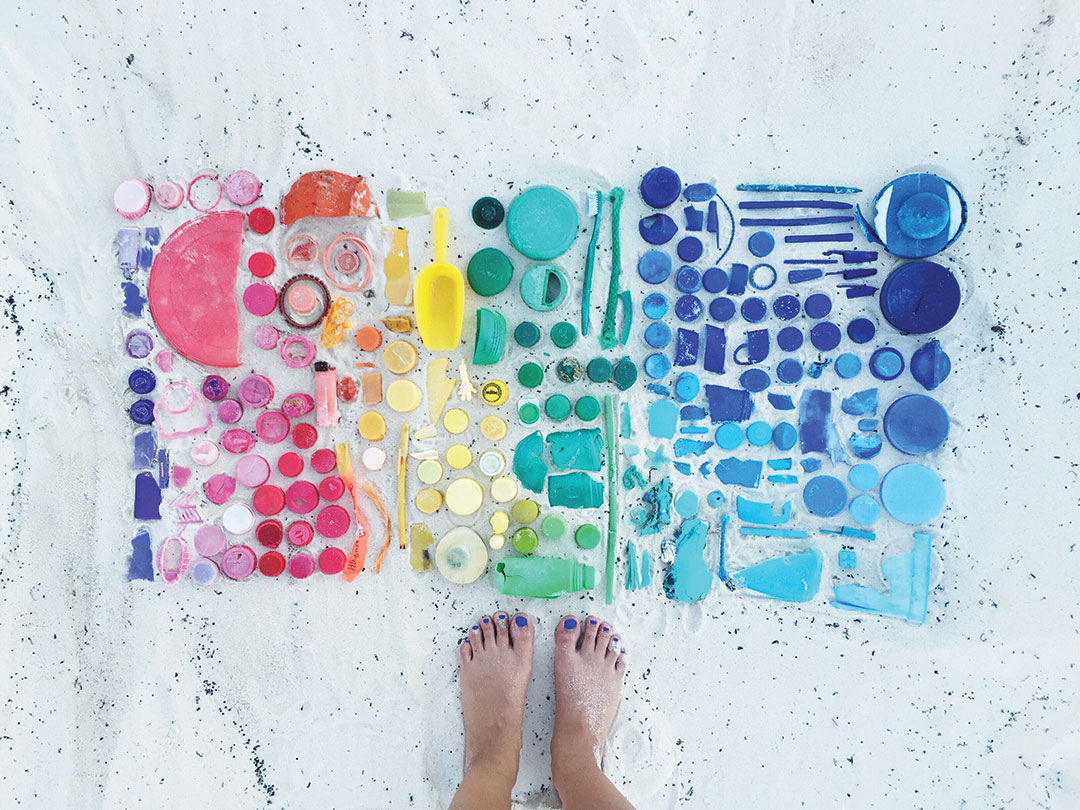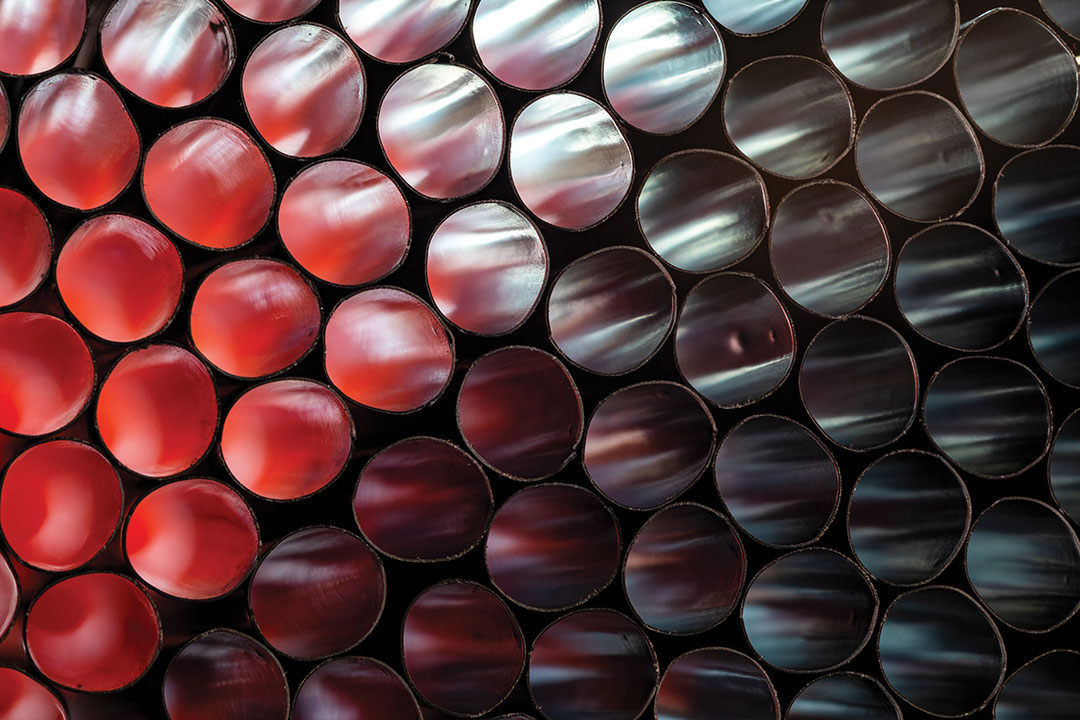
The Final Straw
BOTTLES FROM THE BOTTOM
Plastic has enriched our lives in many ways. It is durable, stable, affordable and enables the creation of important items, from heart valves to eyeglasses. It also protects products for consumption, ensuring safety, reducing contamination, and extending shelf life while improving fuel efficiency in transport due to its light weight. The rise of plastic use across various industries over the past fifty years can be attributed to these qualities. Yet, many of these qualities are exactly what makes plastic such a threat to our oceans and freshwater bodies.
Using marine plastics helps to increase consumer awareness of this issue.
Plastics have been detected in water taken from all oceans and freshwater systems are not free from contamination either: according to projections taken from the World Economic Forum’s New Plastics Economy report, the volume of plastic being dumped into the oceans will double by 2030, and it is expected that, by weight, there will be more plastic in our oceans than fish by 2050. While plastic packaging is not the sole cause of ocean plastic waste and marine litter, packaging producers are expected to lead significant change by presenting solutions to support healthier aquatic ecosystems.
TOWARDS A CIRCULAR ECONOMY
Litter is either the consequence of an end user’s behaviour or the lack of available waste management infrastructure to handle the material in that end user’s geography. But that does not mean that the packaging community cannot promote change in the consequence of the 32% plastic collection leakage (World Economic Forum) and drive towards a Circular Economy, a restorative and regenerative model where materials flow in a continuous loop. Incorporating recycled content into packaging supports and strengthens recycling programs that are critical to the circular economy.
There are examples in the marketplace of companies that use a percentage of recycled ocean and river plastics debris in their packaging by collecting them from aquatic environments, separating them from non-plastic debris and then re-processing them to form plastic pellets that can be incorporated into new packaging.Despite the volume of plastics in the marine ecosytems, collecting them isn’t cheap or easy. Even the infamous island of junk floating in the Pacific is so diffuse, that it isn’t practical to just scoop it out of the water. The trick is locating exactly where along the shorelines it collects in enough quantity for local teams to gather, sort through and process at a commercial scale.
Re-purposing debris is also costly because it is difficult to sort such a wide range of mismatched sizes and colours of so many plastic resins; this being, ocean plastics are usually blended with other recycled materials to maintain packaging quality and stability. Although the time and additional cost of using marine plastics are still a major hurdle and not yet a scalable solution, it does help to increase consumer awareness of the issue and provides support to clean up projects working to conserve shorelines and aquatic environments.
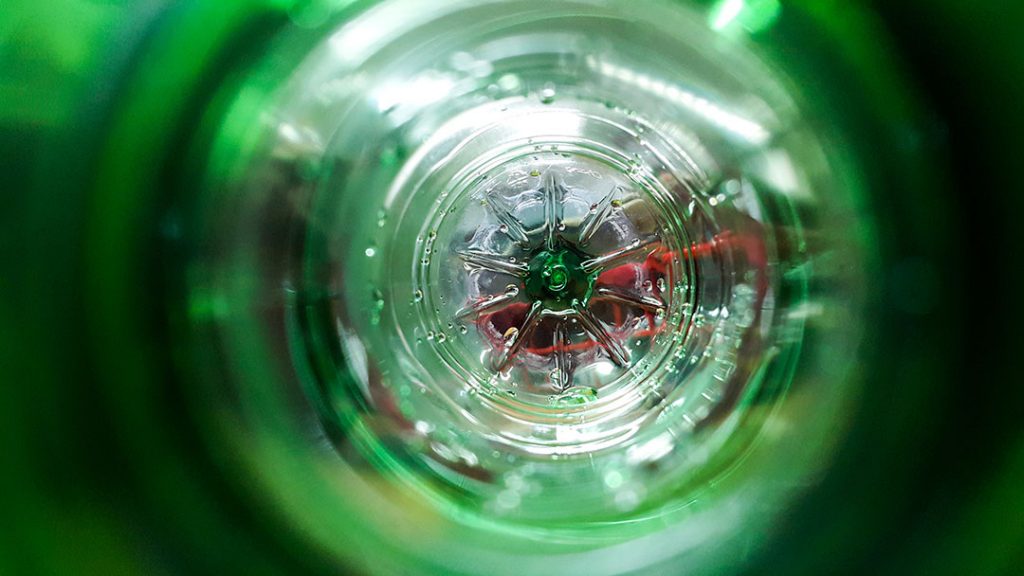
100% RECYCLABLE
11% MARINE PLASTIC
89% POST-CONSUMER RECYCLED PLASTIC
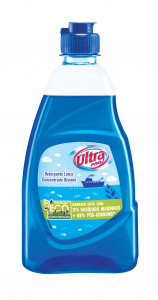
Pindo Doce/Biedronka new dishwashing detergent bottle made of 100% recyclable and recycled plastic.
With companies constantly striving to balance profit with demand for sustainability, will more packaging producers enter the field in the future? We are seeing a paradigm shift, with numerous companies introducing waste management infrastructures and supporting deposit return schemes. Increased collaboration among stakeholders, commitment to sustainability and demonstrated viability will drive more packaging producers towards ocean plastic, boosting demand and lowering costs over time.
With global plastic production projected to rise, and plastic packaging representing the major share of this leakage into aquatic environments, our oceans and freshwater bodies need companies to act more decisively than ever before. While packaging producers cannot solve the global plastic pollution crisis alone, they are well positioned to advance the circular economy to reduce the consequence and scale of packaging’s impact throughout the value chain, where scientists, policymakers, consumers and other stakeholders can fuel momentum and collaboration and drive longlasting, meaningful change.
GUARDIANS OF THE SEA
The ocean remains one of the most expansive, mysterious, diverse and full of life places on Earth. But we are not doing enough to protect it: some eight million tonnes of plastic end up in the oceans every year. That’s the equivalent to fifteen grocery bags filled with plastic for every meter of coastline in the world. Plastic litter keeps being accumulated over time at the centre of major ocean vortexes forming ‘garbage patches’ – large masses of floating debris fields across the seas. Each of the major oceans have plastic-filled gyres, including the well-known ‘great Pacific garbage patch’ that covers an area roughly equivalent to the State of Texas. What can be done?
NGOs like Waste Free Oceans, a Brussels-based public-private partnership, are now addressing this growing concern of marine litter and committed to fight and prevent it, by partnering and collaborating with fishermen and local communities from around the world in the collection of ocean waste.
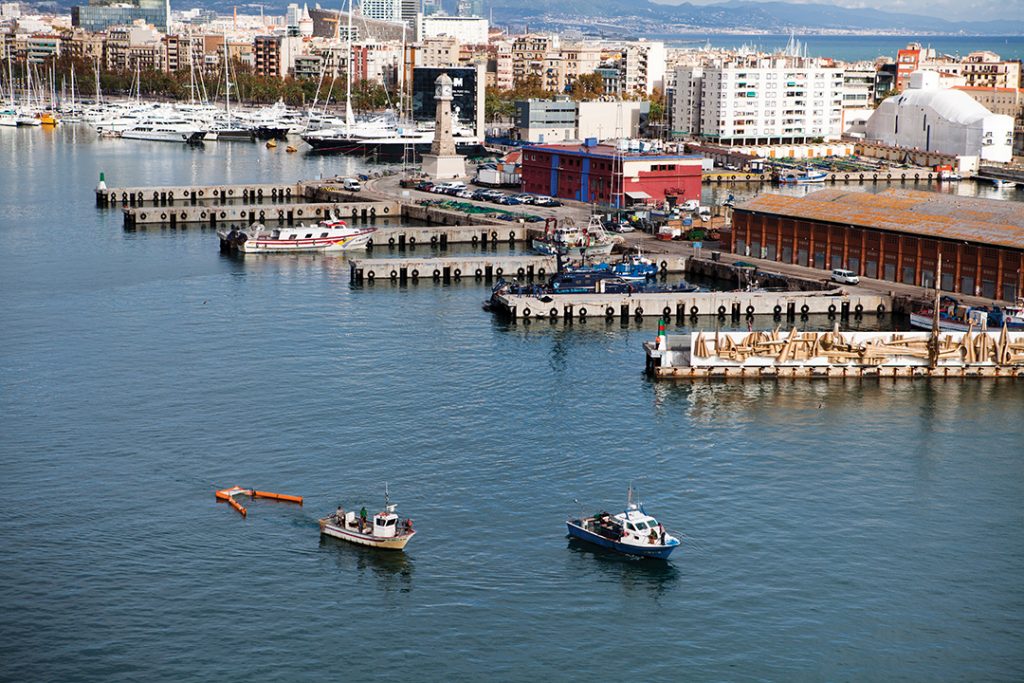
Founded in 2011 as an initiative from the European plastic converters association, WFO has since grown into an independent organisation relying on funding from public donations, project collaborations and corporate partnerships. It operates worldwide and its network is spread all over Europe, as well as in Asia and the Americas, from countries such as Belgium (where it is based), Portugal and Cyprus to Turkey, Hong Kong or the Dominican Republic, to name a few.
WFO’s main goal is to reduce, reuse and ultimately recycle marine litter, mitigating its global impact on both the environment and natural resources, by mobilising fisheries, recyclers, manufacturers, brands and policy makers to try to solve this problem. This is why its main operations include conducting marine litter and beach clean-ups, policy advocacy and collaborating with partners on ‘closing the loop’ projects, designed to transform collected marine litter into new, innovative products, thus promoting the circularity of materials.
HOW IT WORKS
Material litter hotspots are first identified by local partners. Fishermen play a key role in this environmental process, as they are present in the fishing areas all year long they are familiar with local water conditions. They also have the necessary technical knowledge and tools, such as vessels, to keep a good surveillance across large sea areas. Using a quite simple trawl that can be attached to their regular fishing boats, fishermen can ‘fish’ for plastic bottles, the so-called ‘ghost nets’ and other plastic wastes in their idle fishing days, collecting between two and eight tonnes of marine litter in each journey. But even though there are huge amounts of plastic out there in the oceans, overall the quantities collected are just a few hundred tonnes per year.
THE AZORES PROJECT
One of the local partnerships developed by WFO is located in the Portuguese archipelago of Azores and aims to clean-up and prevent plastic pollution in the Atlantic Ocean. The overall goal of the Azores project is to remove floating marine litter of the coastline of São Miguel island and raise awareness of stakeholders by collecting information that proves the impact of marine debris. It will also assess how WFO could set up a preventive collection scheme for obsolete fishing gear by applying for a Fishing for Litter project under the European Maritime and Fisheries Fund, in which fishermen and local organisations could be involved.
Nowadays, the world is ready and waiting for products offering environmental solutions. People are demanding sustainable choices and are getting ready to pay for them. Some years ago, the western world was not yet aware of the impact of marine litter, nor was it prepared to get involved. Today, it has become clear that instead of extracting more natural resources to produce even more plastic products, everybody is getting eager to use more and more sustainable solutions.
